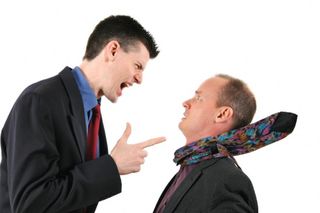Bullying
Political Bullies and Your Child
Kids encounter politics and with it, hate speech.
Posted March 18, 2016

This political season is one for the books. Regardless of political affiliation or views, many of us are hooked on the latest twists and turns of this spectacularly unprecedented and unpredictable political race for the presidential nominations in both the Republican and Democratic parties. Never before—at least in modern memory—have so many expectations been overturned, so many surprises surfaced.
Not the least of these surprises is the language of the leading contender (as of this writing) for the Republican Party nomination to run for president. Donald Trump regularly peppers his political speeches with insults, put-downs, and “potty words.” In fact, his litany of insults against opponents, journalists or anyone disliked comes straight from the grade school bullies’ playbook. He calls them “babies,” “losers,” “little,” “a nothing,” and urges them to “go home to mommy.” These short, simple words (pegged at a 2nd grade reading level) are precisely the words most often found in the verbal insults schoolyard bullies hurl at young children.
Surveys and polling don’t tell us how many children and teens are absorbing Mr. Trump’s speeches on television, radio, newspapers or social media. From one perspective, we hope the answer is: “A great many.” For any democracy to thrive, civic engagement should start early and build steadily as children mature. In this case, however, when we encourage children to watch, listen and pay close attention to the words of political actors in the current nomination race, we are also exposing them to classic bullying language and threats, this time coming from an important and influential adult. Do we seek to engage children and teens in the current political drama, or do we try to censor, protect, or ignore the bullying that has become part of it?
The dangers of political bullying. Many research studies, conducted around the world, agree that children are regularly exposed to bullying and that it has harmful effects. One estimate suggests that 45% of all the world’s children experience some bullying. Almost all research, however, has focused on school-based bullying by peers or slightly older children, with some attention to the ways older siblings may bully their younger brothers and sisters. Lately, concern has focused on cyber-bullying (also largely by peers) as a threat to children’s well-being. In these scenarios, victims of bullying have lower self-esteem and achievement, higher somatic and mental health symptoms. (Such symptoms also may antedate the bullying and make victims more vulnerable to it.)
While we have some indication of how damaging being the direct victim of bullying can be, we know much less about the effects of witnessing bullying. We do know that the social climate may normalize or even encourage bullying or, conversely, may label it as non-normative and deviant. Recent school based studies suggest that when teachers and school personnel create an atmosphere that discourages bullying, children feel more empowered to defend other children when they are victimized. As a result, bullying is much lower in such classrooms.
We also know much about the powers of observational learning. When children observe a person who models, or exhibits, certain speech or behavior – particularly when that person appears to be a powerful and influential adult—children will learn without being directly rewarded. The speech or behavior will enter their repertoire and be available for use later. We also know that the same observations repeated over time will deepen such learning. Thus, when bullying language, or other hate speech is “normalized” by adults in the media, it becomes part of the social landscape of a child’s world.
The upside of political bullying. Now that the language of bullying has entered our political discourse in a big way, we might find a silver lining in this dark cloud. We can start with the civics lesson it provides in First Amendment guarantees of free speech, including speech many might find hateful. When our children hear bullying and demeaning speech from presidential candidates, it’s a teachable moment in understanding that this is precisely the speech that our liberties protect, as long as it is not a direct incitement to violence. Such a First Amendment lesson also can include the idea of “more speech” to counteract hate speech. Children or teens could be encouraged to write letters or submit essays to the school newspaper that contain reasoned rebuttals to bullying language.
Not every teen will be on a school debate team. But the discipline of framing an argument—without resorting to hate speech and ad hominem attacks—on both sides of an issue is a valuable one. Such an exercise forces one to take the perspective of an opponent, a building block of empathy. Parents and teachers might incorporate such habits of thinking and reasoning in conversation.
However, studies of parents’ understanding of bullying by peers at school or through cyber-bullying find considerable confusion. Parents often aren’t sure how to distinguish bullying from teasing or “picking on” others, acts that many consider a “normal part of growing up.” Even more confusion reigns when parents are faced with what to do. Some parents take action, others advise the child to ignore the bully, retaliate, or find a way to “work it out.” In general, parents feel helpless to deal with bullying when their children are victims or perpetrators. All this suggests that children’s observations of political bullying and hate speech will be a confusing terrain for parents.
Nonetheless, bullying in the political domain should be a prod to parents. It’s a chance to reflect on the language atmosphere at home when discussions of difference emerge. Research suggests that empathy in children is nurtured by home environments that recognize and respect multiple perspectives. When parents are fervent political partisans in an overheated political race – a good sign of civic engagement in the democratic process—they can slip into rhetoric that demeans and delegitimizes opponents. In turn, such rhetoric is amplified in a political climate saturated by negative person-directed advertising. Can we all be engaged and committed to political causes without resorting to personal attacks that can slide easily into bullying language? Our kids—future voters in not so many years—will benefit. Our democracy will be much the better for it.
To read further:
Arneback, E. (2014). Moral imagination in education: A Deweyan proposal for teachers responding to hate speech. Journal of Moral Education 43, 269-281.
Harcourt, S., Jasperse, M., & Green, V. (2014). ‘We were sad and we were angry’: A systematic review of parents’ perspectives on bullying. Child & Youth Care Forum 43, 373-391.
Peets, K. et al. (2015). Classroom norms of bullying alter the degree to which children defend in response to their affective empathy and power. Developmental Psychology 51, 913-920.




